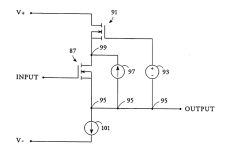I just read from the latest tubecad blog that Nelson had in the past a design where a cascode is used to create a very efficient Class A buffer amplifier. Principle is similar to Class G but the higher cascode Mosfets (used for high power) are slightly biased at all time to avoid switching in and out when higher power is needed. Seems like a very interesting concept but I do not notice any discussion on this concept in this forum so far. Is there any reason why this concept never becomes a working project? I am planning to test out this concept and build a 20-25W class A buffer.
https://www.tubecad.com/2024/06/blog0603.htm
https://www.tubecad.com/2024/06/blog0603.htm
I wonder why Papa didn't pursue this further. Perhaps the added complexity of multiple power supplies and other components?
I look into the configuration and indeed find that the power supply can be rather complicted. The heavily biased low voltage supply is floating and it appears that the left and right channels need to be supplied independently. SMPS can be a solution.
I ran simulations of the circuit in https://www.tubecad.com/2024/06/blog0603.htm.
My conclusion is that the distortion can be quite low but the harmonic fall-off" is very poor.


My conclusion is that the distortion can be quite low but the harmonic fall-off" is very poor.
The hard part with these amplifiers is the point where the auxiliary supplies kick in. There is a bit of balancing between ensuring the auxiliary supplies turn on fast enough to work properly at 20kHz but also slow enough as to not inject rubbish at turn on. Key is having plenty of bandwidth in the main amplifier to correct the output when this happens.
I've done 0.003% with some 100 and 200W MOSFET amplifiers, that work quite nicely. They are wonderfully efficient compared to normal class A/B.
There's nothing difficult about the supplies - you just need a supply for the low voltage (+/-25 odd volts) and one for the auxiliaries. The low voltage supplies can serve double duty running your opamps etc, or running a lower power amp for a multi-way system.
See https://www.diyaudio.com/community/threads/a-small-class-h-lateral-mosfet-amplifier
I've done 0.003% with some 100 and 200W MOSFET amplifiers, that work quite nicely. They are wonderfully efficient compared to normal class A/B.
There's nothing difficult about the supplies - you just need a supply for the low voltage (+/-25 odd volts) and one for the auxiliaries. The low voltage supplies can serve double duty running your opamps etc, or running a lower power amp for a multi-way system.
See https://www.diyaudio.com/community/threads/a-small-class-h-lateral-mosfet-amplifier
Link was broken. see https://www.diyaudio.com/community/...lateral-mosfet-amplifier.365176/#post-6465613
Thanks, and this comes without any overall feedback and at 25W. With most music passages at about or below 1W things can be better. The harmonic profiles do look strange.I ran simulations of the circuit in https://www.tubecad.com/2024/06/blog0603.htm.
My conclusion is that the distortion can be quite low but the harmonic fall-off" is very poor.
View attachment 1326167
Single end configuration is my preference. From the patent document the efficiency improvement might be limited. The current source 101 still need to dissipate a full bias current times a full supply voltage (one pole). The compliementary pair might be the way to go.
Attachments
- Home
- Amplifiers
- Pass Labs
- Class G type cascode buffer
